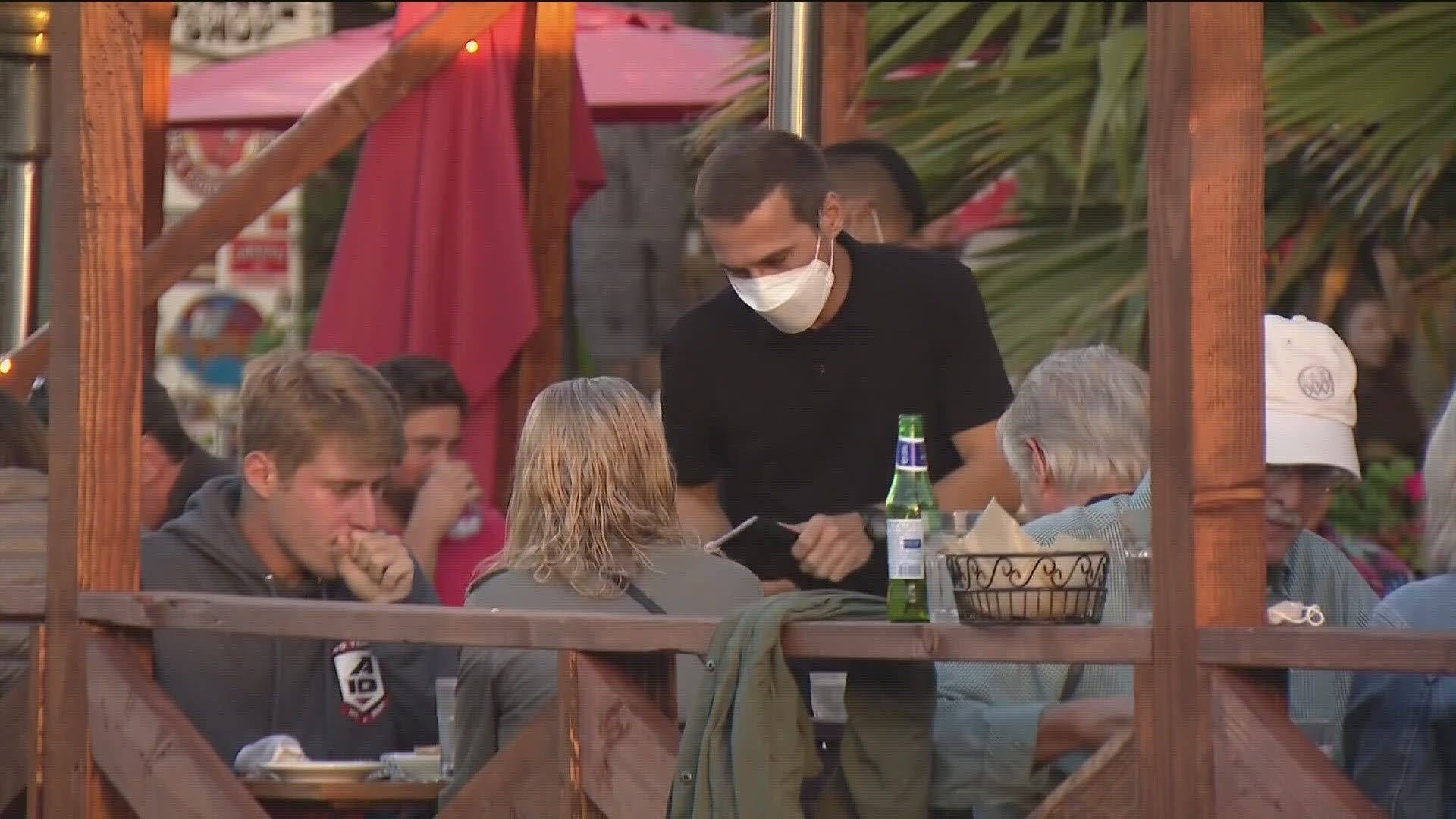SAN DIEGO COUNTY, Calif. — As novel coronavirus cases rise in the U.S., the Centers for Disease Control and Prevention has warned that certain populations are at higher risk of developing severe illness if they contract the respiratory virus.
inewsource teamed up with KPBS to produce an interactive map that shows where in San Diego County the highest concentrations of these populations are clustered, based on CDC and U.S. Census Bureau data. High-risk segments include those 65 and older, people with chronic lung disease or moderate to severe asthma, diabetics, people with serious heart conditions or severe obesity, and those with compromised immune systems.
The goal is to visualize for the public where these vulnerable populations live.
When asked if county health officials are using this kind of data to deploy resources, the county’s medical director for epidemiology and immunization services said they are working with organizations and agencies that deal with these high risk groups.
Dr. Eric McDonald added that no matter where these people live the message is the same: “You are at risk.”
“You should take extra precautions and be sure that you are very aware of your essential activities,” McDonald said.
People 65 and older
Data from South Korea, Spain, China and Italy show the bulk of their coronavirus-related fatalities were among seniors. The U.S. is no different. Current CDC data show that 80% of domestic COVID-19 deaths occurred among adults 65 years and older.
That’s because the human body’s immune system weakens with age, which makes it harder for seniors to fight off disease. More than half of COVID-19 intensive care unit admissions were from this population.
“COVID-19 has really set everybody on their ear,” said Cheryl Wilson, CEO of St. Paul’s Senior Services, a nonprofit that has operated in San Diego County for 60 years. St. Paul’s services include housing, personal and medical care, education, and advocacy.
“When all of this started to break about three weeks ago — prior to it really breaking in the United States — we all got together, realized what was going to happen and started putting our plans into place,” Wilson told inewsource on March 20.


St. Paul’s medical staff began monitoring residents and others who use their services for symptoms of the disease, Wilson said. They also surveyed their stock of personal protective equipment, started sanitizing at the door and offered food delivery, instead of takeout or communal meals.
The highest concentration of people 65 and older in San Diego lies immediately east of Interstate 15 in Rancho Bernardo. More than 75% of the roughly 2,500 people in the location fit that age profile.
Other high concentrations of seniors are in Oceanside and much of La Jolla.


Wilson said although St. Paul’s has no confirmed COVID-19 cases among its residents, some are getting cabin fever — especially those with memory problems.
“That has been our greatest challenge,” she said. The people with Alzheimer's disease or dementia don’t understand why they’re being sequestered.
St. Paul’s is looking for volunteers willing to call or email seniors to ease anxieties they may have at this time.
Wilson said all the volunteers have to do is strike up a conversation: “‘How are you doing this morning? Yes, this rain is terrible, isn't it?”
People with diabetes
The CDC warns that diabetics, particularly those who don’t have the disease well controlled, could be at higher risk of developing complications from COVID-19.
An inewsource/KPBS data analysis shows South County has the highest concentrations of diabetics, which makes sense. The disease disproportionately affects minorities, and that region is home to a majority minority population.
Dr. Neelima Chu, chief of endocrinology at Sharp Rees-Stealy Medical Group, emailed inewsource what she’s seeing among her diabetic patients.
“Patients are appropriately concerned, but we are reassuring them of the risks, symptoms and preventive measures,” Chu said.
She explained that when diabetics become ill with any disease their glucose levels increase. It’s important to address that with more insulin or other medicines, in addition to staying hydrated and continuing to exercise at home.
The good news is insulin companies aren’t reporting any issues with manufacturing or distribution, Chu said, and “patients are not having any issues acquiring their medicines.”
She does recommend diabetics check their medical supplies to make sure they have enough to last at least one month, monitor their glucose levels frequently and follow CDC guidelines.
People with asthma and chronic obstructive pulmonary disease
Dr. Jess Mandel, a pulmonologist and professor of medicine at UC San Diego, said he and his colleagues are “learning on the fly” about how COVID-19 affects people suffering from COPD or asthma.
“We believe that individuals with preexisting pulmonary conditions are at higher risk for a complicated course with COVID-19, but some of that is speculation, in particular with asthma,” Mandel said.
He said his focus “would probably be more on COPD patients just because they tend to be older and definitely more at risk.”
As with diabetics, large groups of asthmatics and COPD-sufferers are clustered in South County. El Cajon and pockets in Escondido, Oceanside and northern San Diego also have higher-than-average numbers, though overall San Diego County has one of the lowest rates of the disease in the country.
“Ultimately,” Mandel said, “we need to get the public health message out that: You're sick, you've tested positive for COVID, overwhelming odds are you're going to do fine, and in fact, we really don't want you to come to the ER and clog the health system.
“And that, for most people, tea and Lifetime original movies will be all that's required to get over it.”
People with heart disease
People with heart disease are scattered throughout San Diego County, but three locations have groups where more than 10% are living with the disease: Carlsbad, Oceanside and Rancho Bernardo.
“We look at our patients as kind of walking on a tightrope to begin with every day, and then this just knocks them out,” said Dr. Eric Adler, a UC San Diego cardiologist and professor of medicine.
Adler said doctors are learning that COVID-19 is highly inflammatory, and that’s causing people with heart problems to be more affected.
“Then what we're seeing on top of that in select patients is COVID actually causing heart problems,” he said. “So we're seeing some patients get a condition called myocarditis, which is an inflammatory condition of the heart. We're seeing patients that are having cardiomyopathy — so the heart isn't squeezing well.
“These are patients, some of them, who did not have heart conditions before the COVID who are developing complications as a consequence of the COVID.”
There is also debate about whether certain cardiac medications make a person more likely to contract COVID-19, Adler said. He recommended that patients with those concerns ask their doctor for an opinion.
One effect the pandemic has had on Adler and his colleagues is they realized that virtual conferencing “is kind of the future of medicine,” he said.
“Our older patients are doing great,” he said. “Many of them, if not all of them, have iPhones and Androids, and they use it to talk to their grandkids and their friends all the time.”
--------------------------------------------
How inewsource created the maps for this story
For this story, a baseline map was built using ESRI databases updated from the U.S. Census Bureau and the Centers for Disease Control and Prevention. Information about people over 65 comes from the Census Bureau’s application program interface. Health ailment numbers come from the CDC and are based on 2016 or 2017 best estimates.
The data is limited and excludes San Diego County’s coastal cities, Imperial Beach, National City and other big populations.
Michael Wayne, a content management system project manager with KPBS, and inewsource created the maps using Mapbox.



